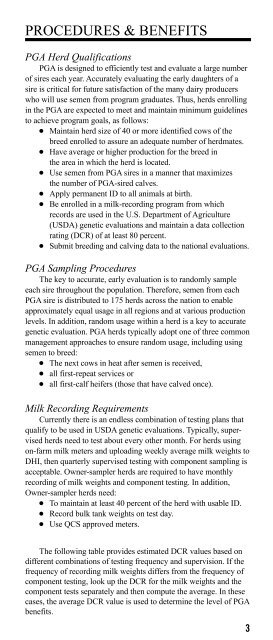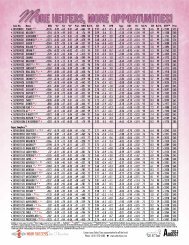Create successful ePaper yourself
Turn your PDF publications into a flip-book with our unique Google optimized e-Paper software.
PROCEDURES & BENEFITS<br />
<strong>PGA</strong> Herd Qualifications<br />
<strong>PGA</strong> is designed to efficiently test and evaluate a large number<br />
of sires each year. Accurately evaluating the early daughters of a<br />
sire is critical for future satisfaction of the many dairy producers<br />
who will use semen from program graduates. Thus, herds enrolling<br />
in the <strong>PGA</strong> are expected to meet and maintain minimum guidelines<br />
to achieve program goals, as follows:<br />
Maintain herd size of 40 or more identified cows of the<br />
breed enrolled to assure an adequate number of herdmates.<br />
Have average or higher production for the breed in<br />
the area in which the herd is located.<br />
Use semen from <strong>PGA</strong> sires in a manner that maximizes<br />
the number of <strong>PGA</strong>-sired calves.<br />
Apply permanent ID to all animals at birth.<br />
Be enrolled in a milk-recording program from which<br />
records are used in the U.S. Department of Agriculture<br />
(USDA) genetic evaluations and maintain a data collection<br />
rating (DCR) of at least 80 percent.<br />
Submit breeding and calving data to the national evaluations.<br />
<strong>PGA</strong> Sampling Procedures<br />
The key to accurate, early evaluation is to randomly sample<br />
each sire throughout the population. Therefore, semen from each<br />
<strong>PGA</strong> sire is distributed to 175 herds across the nation to enable<br />
approximately equal usage in all regions and at various production<br />
levels. In addition, random usage within a herd is a key to accurate<br />
genetic evaluation. <strong>PGA</strong> herds typically adopt one of three common<br />
management approaches to ensure random usage, including using<br />
semen to breed:<br />
The next cows in heat after semen is received,<br />
all first-repeat services or<br />
all first-calf heifers (those that have calved once).<br />
Milk Recording Requirements<br />
Currently there is an endless combination of testing plans that<br />
qualify to be used in USDA genetic evaluations. Typically, supervised<br />
herds need to test about every other month. For herds using<br />
on-farm milk meters and uploading weekly average milk weights to<br />
DHI, then quarterly supervised testing with component sampling is<br />
acceptable. Owner-sampler herds are required to have monthly<br />
recording of milk weights and component testing. In addition,<br />
Owner-sampler herds need:<br />
To maintain at least 40 percent of the herd with usable ID.<br />
Record bulk tank weights on test day.<br />
Use QCS approved meters.<br />
The following table provides estimated DCR values based on<br />
different combinations of testing frequency and supervision. If the<br />
frequency of recording milk weights differs from the frequency of<br />
component testing, look up the DCR for the milk weights and the<br />
component tests separately and then compute the average. In these<br />
cases, the average DCR value is used to determine the level of <strong>PGA</strong><br />
benefits.<br />
3



